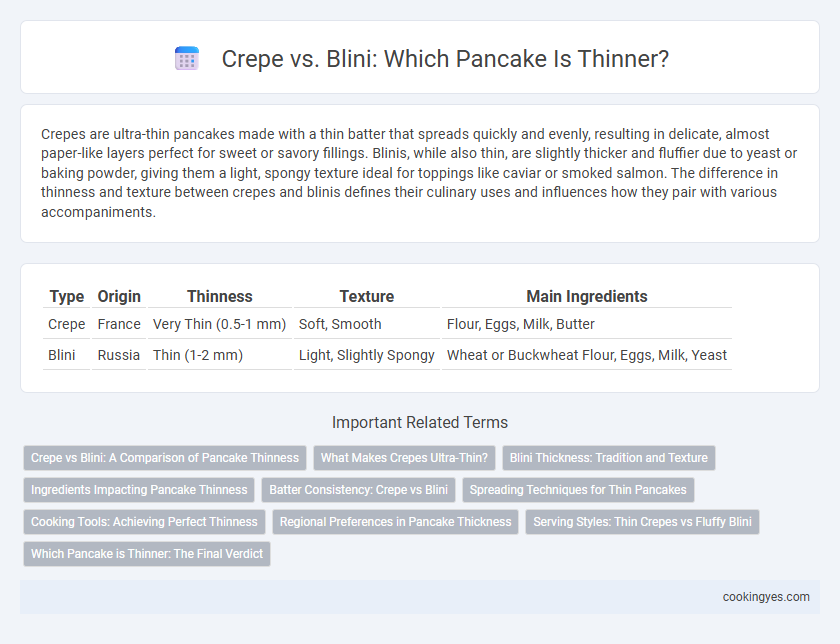Crepes are ultra-thin pancakes made with a thin batter that spreads quickly and evenly, resulting in delicate, almost paper-like layers perfect for sweet or savory fillings. Blinis, while also thin, are slightly thicker and fluffier due to yeast or baking powder, giving them a light, spongy texture ideal for toppings like caviar or smoked salmon. The difference in thinness and texture between crepes and blinis defines their culinary uses and influences how they pair with various accompaniments.
Table of Comparison
| Type | Origin | Thinness | Texture | Main Ingredients |
|---|---|---|---|---|
| Crepe | France | Very Thin (0.5-1 mm) | Soft, Smooth | Flour, Eggs, Milk, Butter |
| Blini | Russia | Thin (1-2 mm) | Light, Slightly Spongy | Wheat or Buckwheat Flour, Eggs, Milk, Yeast |
Crepe vs Blini: A Comparison of Pancake Thinness
Crepes are traditionally thinner and larger than blinis, offering a delicate, almost translucent texture ideal for sweet or savory fillings. Blinis, while also thin, tend to be thicker and smaller with a slightly spongy consistency due to the inclusion of yeast or baking powder in the batter. This difference in thickness impacts their use, with crepes serving as versatile wraps and blinis functioning more like bite-sized pancakes commonly paired with toppings like caviar or sour cream.
What Makes Crepes Ultra-Thin?
Crepes achieve their ultra-thin texture due to a batter composed of a higher ratio of liquid to flour, often including milk and eggs, which creates a smooth, pourable consistency. The cooking technique involves spreading the batter quickly and evenly over a hot, flat surface using a wooden T-shaped spreader, allowing for an even, paper-thin layer. In contrast, blini batter is thicker and yeast-leavened, resulting in a fluffier texture rather than the delicate thinness of crepes.
Blini Thickness: Tradition and Texture
Blini are traditionally thicker than crepes, offering a denser texture that holds toppings and fillings without tearing. Their slight fluffiness comes from a yeast-based or buckwheat batter, contrasting with the delicate, almost paper-thin crepes made from wheat flour. This thickness preserves a satisfying bite, making blini ideal for savory combinations and a distinctive experience in Eastern European cuisine.
Ingredients Impacting Pancake Thinness
Crepes achieve their characteristic thinness primarily due to a high ratio of milk to flour and a lack of leavening agents, creating a fluid batter that spreads easily on the pan. Blini incorporate yeast or baking powder and sometimes eggs, resulting in a slightly thicker, airier texture despite being thin. The different ingredient compositions directly influence the batter's viscosity and the resulting pancake thickness, with crepes being the thinnest traditional option.
Batter Consistency: Crepe vs Blini
Crepe batter is typically thin and runny, allowing it to spread quickly and create a delicate, paper-thin pancake. In contrast, blini batter is thicker and often contains yeast or sourdough, resulting in a slightly thicker, fluffier texture. The difference in batter consistency significantly influences the thinness and texture of the final pancake.
Spreading Techniques for Thin Pancakes
Crepes achieve their signature thinness through a smooth batter poured onto a hot pan, immediately tilted and rotated to evenly spread the mixture in a thin, uniform layer. Blinis rely on a thicker batter and often use a spoon to gently spread the mixture, resulting in a slightly thicker, fluffier pancake. Mastering the spreading technique significantly impacts the final texture and thinness of pancakes, with crepe methods favoring near-transparency and blini techniques creating a tender, airy bite.
Cooking Tools: Achieving Perfect Thinness
Crepes require a non-stick, flat skillet or specialized crepe pan to ensure even heat distribution and ultra-thin batter spreading, often using a T-shaped spreader for precision. Blinis are typically cooked on a cast iron or heavy skillet, which maintains steady heat for thicker, fluffier results, and are ladled rather than spread thinly. Utilizing the correct pan type and spreading technique is crucial for achieving the signature thinness of crepes versus the slightly thicker texture of blinis.
Regional Preferences in Pancake Thickness
Crepes, originating from France, are known for their ultra-thin, delicate texture that is ideal for sweet or savory fillings, reflecting a regional preference for paper-thin pancakes. In contrast, Russian blinis maintain a slightly thicker and fluffier consistency, catering to traditional tastes favoring hearty, yeast-leavened pancakes often served with caviar or sour cream. These regional thickness variations highlight cultural differences in pancake preparation and consumption across Europe.
Serving Styles: Thin Crepes vs Fluffy Blini
Crepes are ultra-thin pancakes often served folded or rolled with sweet or savory fillings, emphasizing delicate texture and presentation. Blinis, by contrast, are thicker and fluffier, typically topped with rich ingredients like sour cream and caviar, highlighting their soft, airy bite. The contrast in serving styles--crepes' elegant folds versus blinis' dollop-and-serve approach--distinguishes these pancakes through thickness and culinary experience.
Which Pancake is Thinner: The Final Verdict
Crepes are typically thinner than blinis, with a smooth, delicate texture achieved by using a thinner batter and spreading it evenly over a hot surface. Blinis, made from a yeast-leavened batter, have a thicker, fluffier consistency and a slightly spongy texture. For those prioritizing thinness, crepes present the final verdict as the thinnest pancake option.
Crepe vs Blini for Pancake Thinness Infographic

 cookingyes.com
cookingyes.com